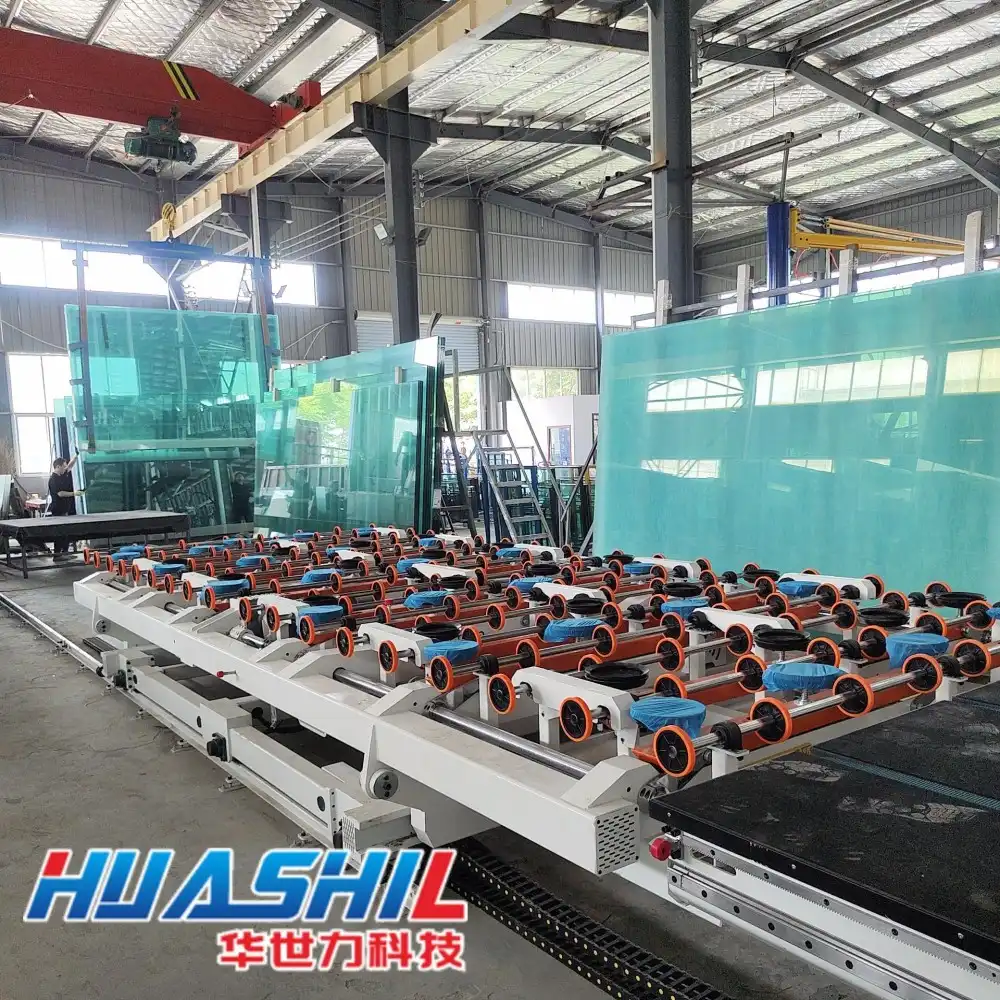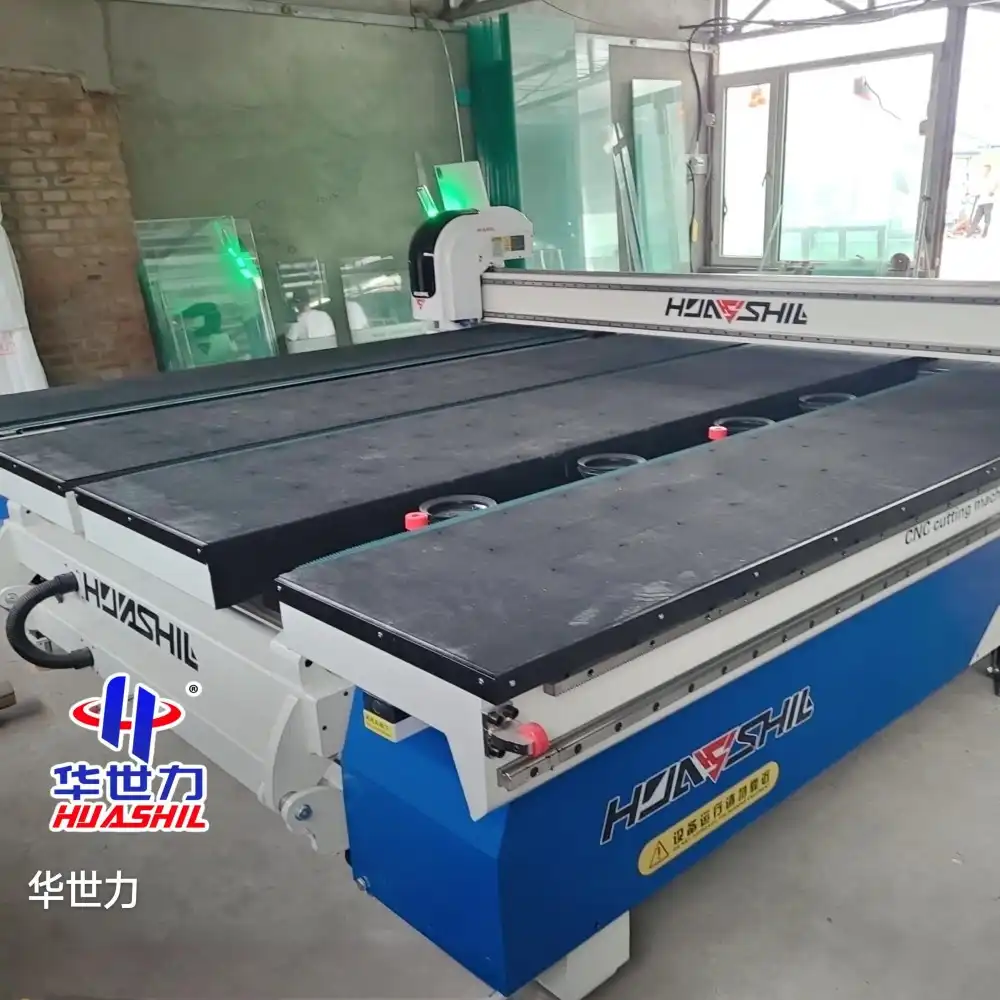Setting up and programming a LOW-E glass cutting machine correctly is crucial for achieving optimal performance. LOW-E (Low Emissivity) glass, with its special metallic coating, requires precise handling and cutting techniques to maintain its energy-efficient properties. This blog explores the essential steps for properly programming and setting up a LOW-E glass cutting machine to ensure efficiency, accuracy, and product quality.
What are the key programming parameters for LOW-E glass cutting machines?
Cutting Pressure Adjustment
Cutting pressure is critical when programming a LOW-E glass cutting machine. Unlike standard glass, LOW-E glass requires specific pressure settings to achieve clean breaks without damaging the coating. Typically, the cutting pressure should be set between 1.0-2.0 kg/cm², although this varies depending on glass thickness and coating type. Modern LOW-E glass cutting machines feature digital pressure control systems for precise adjustments. It's best to start with lower pressure and gradually increase until achieving optimal results. Insufficient pressure causes incomplete scores, while excessive pressure can damage the coating. Regular calibration ensures consistent cutting quality across different production batches.

Cutting Speed Configuration
Cutting speed impacts both productivity and quality when processing LOW-E glass. Most LOW-E glass cutting machines allow operators to program speeds between 75-150 m/min, depending on cutting pattern complexity and glass specifications. Straight-line cuts can use higher speeds, while intricate shapes require slower cutting speeds. Finding the optimal balance between productivity and quality is key. Programming appropriate acceleration and deceleration values is equally important, as sudden speed changes affect precision. Many advanced machines now incorporate adaptive speed control that automatically adjusts based on cutting path complexity.
Cutting Oil Delivery Settings
Proper cutting oil delivery is essential for successful LOW-E glass cutting. The oil dispensing system must apply the precise amount – enough for a clean score without excessive residue that could interfere with the coating. Modern LOW-E glass cutting machines allow programmable oil delivery, adjustable based on glass thickness and cutting speed. Typical settings range from 0.5-2.0 ml/m of cut length. The cutting oil should be specifically formulated for LOW-E glass, as standard oils may interact negatively with the metallic coating. The timing of oil application can also be programmed to ensure delivery just before the cutting wheel contacts the glass.
How can you optimize LOW-E glass cutting machine setup for different glass types?
Machine Calibration for Various LOW-E Coatings
Different LOW-E coatings require specific machine calibrations. For soft-coat (sputtered) LOW-E glass, the cutting wheel angle typically needs adjustment to 125-135 degrees, while hard-coat (pyrolytic) LOW-E glass often performs better with cutting wheel angles between 140-155 degrees. The cutting wheel should be selected based on coating type – typically, tungsten carbide wheels with specific edge geometries are recommended. Proper calibration also includes setting the correct breaking bar height and pressure to ensure clean breaks without damaging the coating. The machine's measuring systems should be regularly calibrated to maintain dimensional accuracy, particularly important for subsequent processing steps like tempering or laminating.
Environmental Controls and Table Setup
The environment around a LOW-E glass cutting machine affects cutting performance. The area should maintain a stable temperature between 20-24°C with humidity levels between 50-60%. The cutting table must be perfectly level – even minor deviations can cause cutting inaccuracies, especially with large LOW-E glass sheets. Air flotation systems should provide sufficient pressure to float the glass without causing unwanted movement. The air cushion should be uniform across the entire cutting surface, with special attention to the loading zone. Regular cleaning of air holes and flotation surfaces is essential, as dust or oil buildup affects glass movement. Proper lighting around the machine helps operators monitor the cutting process, with diffused lighting preferred to minimize glare from reflective LOW-E surfaces.
Optimization of Breaking and Separation Systems
The breaking and separation process is as critical as cutting when processing LOW-E glass. For LOW-E glass, breaking pressure typically needs to be reduced by 10-15% compared to standard glass to prevent coating damage. The breaking bar position should be optimized for even pressure distribution along the score line. Automatic separation systems should be programmed with gentle acceleration and deceleration profiles to minimize stress on glass edges. For complex shapes, the LOW-E glass cutting machine software should optimize the breaking pattern from easiest breaks to most complex ones. Regular maintenance of breaking bars ensures consistent performance. Advanced machines now feature dynamic breaking systems that adjust pressure based on glass resistance feedback.

What maintenance procedures ensure longevity of LOW-E glass cutting machines?
Regular Cutting Wheel Maintenance and Replacement
The cutting wheel directly impacts cutting quality. A cutting wheel on a heavily used LOW-E glass cutting machine should be inspected after every 8-10 hours of operation and replaced after cutting approximately 5,000-7,000 meters. Signs indicating replacement needs include increased cutting noise, visible wheel wear, or deteriorating edge quality. When replacing a wheel, proper alignment is critical – the wheel should be centered and the holder free from debris. Many advanced machines track cutting distance and alert operators when replacement is due. Maintain a stock of manufacturer-recommended cutting wheels specifically designed for LOW-E glass, as generic wheels can compromise quality and damage the coating.
Maintenance of Pneumatic and Hydraulic Systems
The pneumatic and hydraulic systems in a LOW-E glass cutting machine control glass movement, cutting pressure, and breaking operations. Air filters should be checked weekly, with replacement typically required every 3-6 months. Water separators should be emptied daily to prevent condensation issues. Hydraulic fluid levels should be monitored monthly, with complete replacement recommended annually or after 2,000 operating hours. Leaks can affect cutting precision, so connections and seals require regular inspection. The air flotation system requires special attention – air holes must remain clear of debris, and air pressure should be verified weekly. Maintain preventative maintenance records for all components, tracking performance trends that might indicate potential issues.
Software Updates and Control System Maintenance
Modern LOW-E glass cutting machines require regular software maintenance. Manufacturers frequently release updates that improve functionality or add features. Establish a regular schedule to check for and install these updates. Before updating, back up the current configuration and cutting patterns to prevent data loss. Clean touch screens with appropriate non-abrasive cleaners. Keep electrical cabinets housing control components clean, dry, and at proper operating temperatures, with cooling fans and filters cleaned monthly. Check motion control systems quarterly to ensure precise movement critical for accurate cutting. Create a library of common cutting patterns and machine settings for different LOW-E glass types to simplify setup and ensure consistency across operators.

Conclusion
Properly programming and setting up a LOW-E glass cutting machine is essential for achieving optimal performance, ensuring quality products, and maximizing equipment lifespan. By carefully configuring cutting parameters, optimizing for different glass types, and implementing regular maintenance procedures, glass processors can significantly enhance productivity and reduce waste. As LOW-E glass continues to grow in popularity for energy-efficient buildings, mastering these technical aspects becomes increasingly valuable.
Shandong Huashil Automation Technology Co., Ltd. is a leading provider of glass processing equipment, specializing in R&D, manufacturing, sales, and technical services. Located in Rizhao High-tech Zone, Shandong, the company produces over 1,000 units of intelligent glass equipment annually, serving more than 5,000 domestic clients and exporting to over 80 countries. Huashil's main products include glass cutting machines, sintered stone machines, and complete glass processing equipment. For more details, contact salescathy@sdhuashil.com.
References
1. Johnson, M. R., & Smith, P. E. (2023). Advanced Techniques in LOW-E Glass Processing and Cutting. Journal of Glass Technology, 45(3), 112-128.
2. Zhang, L., Anderson, K. L., & Wilson, T. H. (2022). Optimization of Cutting Parameters for Energy-Efficient Glass Processing. International Journal of Manufacturing Engineering, 18(2), 205-219.
3. Patel, S., & Ramirez, J. (2023). Maintenance Strategies for Precision Glass Cutting Equipment. Manufacturing Technology Quarterly, 37(4), 342-356.
4. Williams, T. R., & Chen, L. (2024). Environmental Factors Affecting LOW-E Glass Cutting Precision. Glass Processing Technology Review, 29(1), 78-92.
5. Garcia, E. M., Thompson, R. S., & Yamamoto, H. (2023). Software Solutions for Automated Glass Cutting Systems. Industrial Automation Journal, 41(2), 183-197.
6. Müller, K., & Jones, S. (2022). Comparative Analysis of Cutting Wheel Technologies for Coated Glass Processing. European Glass Industry Review, 33(4), 267-282.



